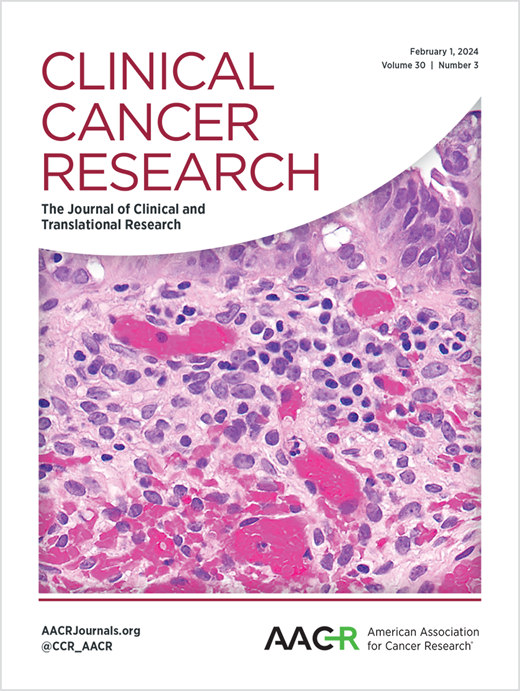利用患者衍生异种移植物建立胆道癌精准肿瘤学模型
IF 10
1区 医学
Q1 ONCOLOGY
引用次数: 0
摘要
目的:胆道癌(BTC)是一种罕见的侵袭性恶性肿瘤,富含可用于临床的分子改变。该领域面临的一大挑战是缺乏能再现这些肿瘤不同分子特征的临床相关 BTC 模型。本研究的目的是收集能反映 BTCs 基因组改变谱的患者衍生异种移植(PDX)模型,为精准肿瘤建模提供资源。实验设计:PDX 来源于手术切除或转移活检收集的 BTC。通过全外显子组测序和 RNASeq 鉴定 PDX 中存在的基因改变。用已获批准的药物和研究药物治疗 PDX。疗效根据肿瘤体积与基线相比的变化进行评估。无事件生存期定义为肿瘤从基线翻倍的时间。第21天时对反应进行分类:肿瘤体积减少30%=部分反应;肿瘤体积增加20%=疾病进展;任何非PR/PD均视为疾病稳定。结果:基因组测序显示该队列中存在关键的可操作改变,包括FGFR2、IDH1、ERRB2、PIK3CA、PTEN和KRAS的改变。RNAseq 显示了抗体药物共轭靶点的融合和表达,包括 TROP2、HER2 和 Nectin4。治疗匹配显示了对已获批准和正在研究的药物的客观反应,这些药物在临床上已被证明具有抗肿瘤活性。结论:在这里,我们建立了一个 BTC PDX 目录,并对其进行了全面的分子谱分析和治疗建模。这是迄今为止收集的最多的 BTC PDX 模型之一,将有助于开发针对这些侵袭性恶性肿瘤患者的个性化治疗方法。本文章由计算机程序翻译,如有差异,请以英文原文为准。
Utilizing Patient-derived Xenografts to Model Precision Oncology for Biliary Tract Cancer
Purpose: Biliary tract cancers (BTCs), which are rare and aggressive malignancies, are rich in clinically actionable molecular alterations. A major challenge in the field is the paucity of clinically relevant BTC models which recapitulate the diverse molecular profiles of these tumors. The purpose of this study was to curate a collection of patient-derived xenograft (PDX) models that reflect the spectrum of genomic alterations present in BTCs to create a resource for modeling precision oncology. Experimental Design: PDXs were derived from BTC collected from surgical resections or metastatic biopsies. Alterations present in the PDXs were identified by whole exome sequencing and RNASeq. PDXs were treated with approved and investigational agents. Efficacy was assessed by change in tumor volume from baseline. Event-free survival was defined as time to tumor doubling from baseline. Responses were categorized at day 21: >30% decrease=partial response; >20% increase in tumor volume=progressive disease, and any non-PR/PD was considered stable disease. Results: Genomic sequencing demonstrated key actionable alterations across this cohort, including alterations in FGFR2, IDH1, ERRB2, PIK3CA, PTEN and KRAS. RNAseq demonstrated fusions and expression of antibody drug conjugate targets including TROP2, HER2 and Nectin4. Therapeutic matching revealed objective responses to approved and investigational agents that have been shown to have antitumor activity clinically. Conclusions: Here, we developed a catalog of BTC PDXs which underwent comprehensive molecular profiling and therapeutic modeling. To date, this is one of the largest collections of BTC PDX models and will facilitate the development of personalized treatments for patients with these aggressive malignancies.
求助全文
通过发布文献求助,成功后即可免费获取论文全文。
去求助
来源期刊

Clinical Cancer Research
医学-肿瘤学
CiteScore
20.10
自引率
1.70%
发文量
1207
审稿时长
2.1 months
期刊介绍:
Clinical Cancer Research is a journal focusing on groundbreaking research in cancer, specifically in the areas where the laboratory and the clinic intersect. Our primary interest lies in clinical trials that investigate novel treatments, accompanied by research on pharmacology, molecular alterations, and biomarkers that can predict response or resistance to these treatments. Furthermore, we prioritize laboratory and animal studies that explore new drugs and targeted agents with the potential to advance to clinical trials. We also encourage research on targetable mechanisms of cancer development, progression, and metastasis.
 求助内容:
求助内容: 应助结果提醒方式:
应助结果提醒方式:


